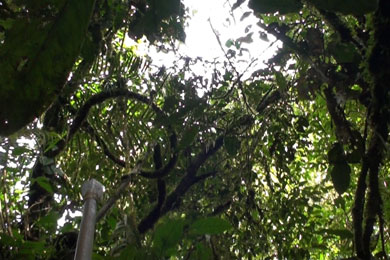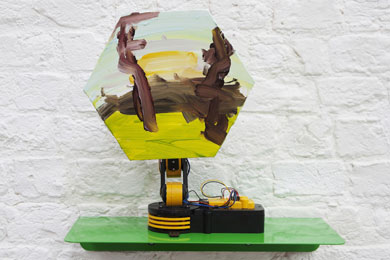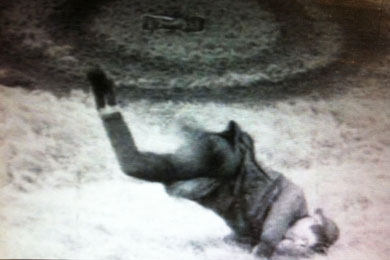
Layla Curtis, Tong Tana, 2012. Video still courtesy the artist.

Juneau Projects, Čapexagon Series (Lickey Hills), 2011. Image courtesy the artists and Ceri Hand Gallery, London.

Andrew Kötting, Klipperty Klöpp, 1984. Film still courtesy the artist.
Layla Curtis, Tong Tana, 2012
Curtis’s work has a focus on mapping and the ways we represent terrain
and locate ourselves and our movements through space. Previous projects
include collages made of maps; drawings produced through the use of
computers and satellite GPS technology whilst in Antarctica with the
British Antarctic Survey; and video work made with parkour practitioners
from London.
Layla Curtis spent four weeks in the rainforests of Borneo with the semi-nomadic Penan – one of the last surviving hunter-gatherer tribes in South-East Asia and acknowledged masters of tracking and hunting.
Her intention was to obtain point of view (POV) video footage of a Penan hunter’s solo journey with blowpipe and poisoned darts through dense jungle near Ba Jawi, one of Borneo’s last remaining pristine rainforest wildernesses. A Penan hunter agreed to go out with a head mounted camera as well as binaural microphones – designed to accurately record sound as experienced by the human ear – and the resultant recordings provide the material for this project.
I aim to place the viewer in the centre of the action and thus
experience the journey from point-of-view of the protagonist. I aim to
create a heightened sensory experience for the viewer and create an
immersive viewing experience within the gallery space. Each of the films
will comprise of a single take of POV footage – the content and pace of
which will be entirely dependent on the self-determined course of the
hunter.
— Layla Curtis
Tong Tana is supported using public funding by the National Lottery through Arts Council England.
The artist would like to thank The Penan of the Upper Baram River, Sarawak, Borneo for their generosity and hospitality. In particular special thanks to Misa, Dennis and Sia. Thanks also to Lukas Fort and Craig Vear for all their continued support and advice and to Maxwell Clark, Tom Hewitt, Mike Prior-Jones, Gennie Rose and Peter Sercombe. Tong Tana was sound mastered by Craig Vear.
Juneau Projects, Čapexagon Series and Sleepwake, 2011
Juneau Projects were formed in 2001 and explore relationships between
technological, social and natural worlds in their work in both visual
art and music and sound. The Čapexagon Series is the results of an attempt to use robotics to make landscape paintings.
The system is set up to allow us to paint en plein air using the
robotic arm: the arm is powered by a laptop and we are able to paint
with it for as long as the laptop has charge. The system was initially
conceived by us in an attempt to consider some of the aspects that are
involved in producing paintings as a duo. There is a constant act of
translation that takes place between us when we are painting and, with
the Čapexagon works, this process is physically manifested in the robotic arm.
The marks produced by the robotic arm are also in opposition to the
perceived ideas of robots being utilised to produce precise mechanical
results. The arm is awkward and imprecise, rendering our interpretations
of landscapes as near-abstract images. Sleepwake was
developed in response to the idea of machines becoming self-aware. Two
strobe lights run inside the sculpture, causing its eyes to blink on off
constantly and echoing the 'thinking' processes that are happening all
the time in our homes and workplaces.
—Juneau Projects
Juneau Projects are represented by Ceri Hand Gallery, London.
Andrew Kötting, Klipperty Klöpp, 1984
Andrew Kötting is a filmmaker, artist and writer whose practice
encompasses sound art, installation, experimental theatre, short film,
artist's books and full length feature films; most recently Swandown,
an installation and film based on a voyage made with Iain Sinclair in a
pedalo from the Hastings coast to Hackney via the Sussex and Kent
waterways.
Klipperty Klöpp is a film of the artist repeatedly and energetically running round a field in Gloucestershire pretending to be a horse. The record of this activity is accompanied by a soundtrack where certain phrases, some from the artist, some from written texts, can be made out from layers of sound.
In all Kötting's work, there is a more or less active reclamation
of deep strains of popular experience and folk memory for the digital
age. His project, vitally, operates against the hollow ordering of
reality and existence. He is closer to the Native American Coyote, to
the trickster, harlequin and knave in his operation than to the career
'administrator' artist. He is most adept at 'making do', at mining the
creative possibilities of material or structural limitation to
invigorating effect.
—Gareth Evans, Lux
Surpasses even the 'Running-Jumping-Standing-Still Film'... a dada classic.
—Phillip Jenkinson, Radio Times, 1986